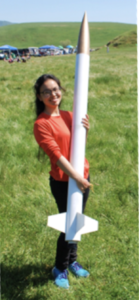In October, we invited Kim Jenks to skype with us about her career as an aerospace engineer. She gave us a very engaging and informative insight on her journey in becoming an aerospace engineer. She also provided many helpful tips if we were also interested in pursuing a career in engineering.
as an aerospace engineer. She gave us a very engaging and informative insight on her journey in becoming an aerospace engineer. She also provided many helpful tips if we were also interested in pursuing a career in engineering.
An aerospace engineer designs, builds, and tests aircraft, spacecraft, rockets, and missiles. Jenks herself currently specializes in missiles. She was initially interested in becoming an aerospace engineer because of her interests in astronomy and physics. Through college courses at UCLA, she cemented her plan on becoming an aerospace engineer. A typical day in her work life can vary. It can include technical and/or social tasks including developing simulation code, analyzing data, improving efficiency in manufacturing, testing hardware, and other responsibilities. These tasks could also include traveling to other places.
She then explained the different requirements and expectations of an aerospace engineer. An aerospace engineer must have honed critical thinking and problem solving skills to help analyze and improve designs, must have a drive to improve not only oneself but also the company, and must have the ability to cooperate with others effectively in a team dynamic. She also recommended joining school clubs such as a robotics team and to focus on certain subjects throughout school including obvious courses like math, physics, and programming. She also explained that a proficiency in English is very important in engineering for expressing results to others. Becoming an aerospace engineer requires at least a bachelor’s degree in engineering, but certain disciplines such as focuses on systems and control, aerodynamics, and propulsion require a master’s degree. Some real-world skills can also be obtained through means of internships and research, but training in the industry comes from hands-on experiences.
Jenks has thoroughly enjoyed her career as an aerospace engineer. From her career, she has been able to do many fun activities like designing and building model airplanes, rockets, and robots, launching a weather balloon, and taking flight lessons. She has also found her career to be very rewarding from doing meaningful work, working with great team members, and being able to travel and explore the world.
Overall, it was very inspiring to learn about her career as an aerospace engineer, and we took a lot of great advice from her journey.